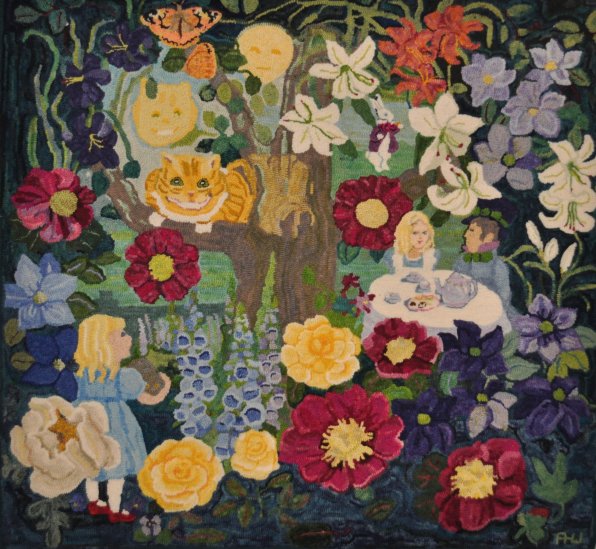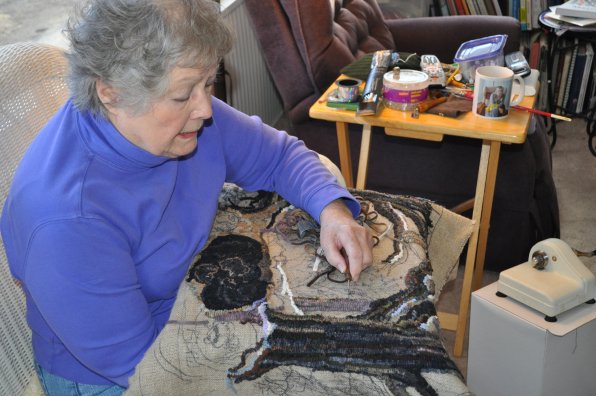The floor is just about the only place in Ann Winterling’s home that you won’t find one of her rugs.
Such is life for one of the more accomplished rug hookers in the region. A Concord resident for more than 40 years, Winterling has had rugs appear in galleries both near and far – including the current display at the League of New Hampshire Craftsmen Gallery – as well as on the front of industry magazines and in a variety of books. Her original works also dot the walls of her living room, bedroom and hallway, and are stashed in all corners of the cottage she shares with her husband, Charles, at Heritage Heights.
That you won’t find them under your feet is simply a function of them being made for eye-level appreciation. You wouldn’t dance on a Da Vinci, would you?
“I started hooking 40 years ago and fell in love with it,” Winterling said. “It’s exciting to me, creating the patterns. It makes you want to get up in the morning because you’ve got something exciting ahead.”
Winterling picked up the practice when she moved to New Hampshire and started working with a teacher in Contoocook, though much of her work reflects memories from long before that. Some of her most prized creations are farm scenes from family dwellings in New York State, including the house in Rhinebeck, N.Y., that she spent the first six years of her life in, and her aunt’s farm house in the same state.
It was at her aunt’s farm that she first developed an interest in fiber art.
“I really treasure those memories,” she said.
Patience is most definitely a virtue in the rug hooking game, which requires unwavering attention to detail. It may be a labor of love, but it’s also rather labor intensive. Especially if you start from scratch as Winterling prefers to.
She purchases wool and dyes it herself, boiling it in water with vinegar or citric acid crystals.
“It takes quite awhile, but you can get wonderful colors that you simply wouldn’t get even if you buy commercially colored wool,” Winterling said.
After drying the wool, she cuts it into thin strips before hooking it through a canvas of linen one painstaking thread at a time, changing strips of wool every time she needs to apply a new color.
She has done pieces in as little as two weeks but has also spent two years working through a project, setting it aside for stretches before returning to the quest. But Winterling has always loved the process as much as the finished product, which is why the art form was such a comfortable fit from the start.
“It was absolutely challenging but it was also very creative, and I loved the part that you could do anything you want,” Winterling said.
And she does. Though many artists choose to work from patterns, Winterling prefers to hook her own original designs, which are inspired by nature and animals but also by mythology and literature. The rug of her childhood home shares wall space in the living room with pieces centered around Alice in Wonderland and a Midsummer Night’s Dream.
Winterling sketches a design on the linen to get things started but often adds freehand changes as she’s hooking, something that at one time more than a century ago was considered taboo.
“Some of the early teachers were pretty autocratic,” Charles said. “You had to do their patterns. The concept of inpidual creativity was very foreign to them.”
Did someone say foreign? Winterling’s success in the field has opened doors to countries all over the world, including England and Australia, though Winterling had to pass on last year’s trip down under because she was busy being one of three featured artists at a gallery show in the Shelburne Museum in Vermont.
She’s also been featured several times in Rug Hooking Magazine and has had one of her rugs appear as the publication’s cover art.
Winterling has evolved from student to teacher, as well. She trained an apprentice as a master teacher and has been instructing budding artists for almost 20 years, something she continues with a group that still meets at her cottage in Concord.
She is happy to pass on her knowledge and hopes to infuse her students with the same passion she has for the craft.
“It’s like meditation; it’s like taking a vacation,” Winterling said. “Because whatever is wrong you can just focus on the work and you feel calm. I think people should all focus more on being creative, because I think we’d have fewer tensions in the world. (People who embrace creative outlets tend to be more) contented with their lives.”
Winterling certainly is, and she sees no end in sight to her rug hooking work. All it takes is a creative mind and willingness to keep learning and the hobby can become a lifelong passion.
“That’s the nicest thing about it, nobody is ever finished as a rug hooker,” Winterling said.










